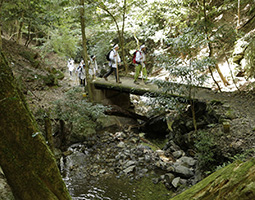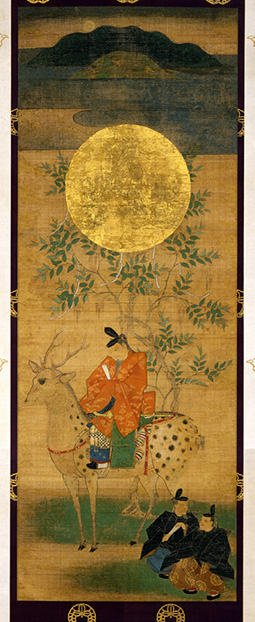
Mt. Mikasa 
A section of the cobblestone Takisaka no michi path 
Hanging scroll titled “Kasuga Deities Departing from Kashima Shrine.” Takemikazuchi-no-Mikoto is depicted descending on the back of a deer, with Mt. Mikasa in the background.
July 2021
The Forest in the Sacred Precincts of Kasugataisha Shrine

The Kasugayama Primeval Forest in Nara City, Nara Prefecture is a sacred forest of Kasugataisha Shrine and a primeval forestial ecosystem that has been sustained by people for more than 1,000 years.

Nara City was the site of the capital Heijo-kyo from 710 to 784 and prospered as a center of politics and culture. Even after the capital moved, it has accumulated more than 1,300 years of history as a former capital, fostering tradition and culture. In 1998, the Nara Palace Site as well as the Kasugataisha Shrine, the Kasugayama Primeval Forest and eight Buddhist temples, including Todai-ji, were jointly registered as UNESCO World Heritage Sites under the name “Historic Monuments of Ancient Nara.” (See Highlighting Japan, December 2020*).
The main building of the Kasugataisha Shrine is said to have been constructed at the order of the emperor in 768. Legend has it that Takemikazuchi-no-Mikoto, one of the deities enshrined in Kasugataisha Shrine, rode down on a white deer from Kashima Jingu Shrine in Ibaraki Prefecture to descend on the 283-m-high Mt. Mikasa to the east of Kasugataisha Shrine. The deer in Nara have thus been protected as messengers of the gods since ancient times, which explains why deer can be seen in many places in Nara City.
Either of and sometimes both the two mountains holy Mt. Mikasa and Mt. Hanayama (497 m), which lie beyond Mt. Mikasa, are referred to as “Kasugayama.” As part of the sacred precincts of Kasugataisha Shrine for more than 1,000 years, the 250 hectares or so of “Kasugayama Primeval Forest,” which includes the two mountains, has preserved its primeval appearance up to today, while people have been prohibited from hunting and felling other than to replenish native species. It is said that more than 2,200 shinji (divine services) take place at the Kasugataisha Shrine every year. Some services take place inside the main shrine, while it is said that others take place at Mt. Mikasa and other locations inside the Kasugayama Primeval Forest, attended only by priests of the Shrine since time immemorial. One reason for the registration as a UNESCO World Heritage Site is this cultural background of ancient faith passed down by the Kasugayama Primeval Forest and the Kasugataisha Shrine together as a unit.

Arai Kiyoshi, a priest at the Kasugataisha Shrine, says, “Services conducted in areas where members of the general public can’t enter are often conducted only by priests. There is solemnity to services performed in the mountains and forest since ancient times.”
Of the Kasugayama Primeval Forest itself, Arai says, “One feature of the forest is that it is a climax forest** in a temperate area so that the forest as a whole is lumpy like a broccoli. It has a gentle appearance unlike mountains planted with artificial forests of conifers such as cedar or cypress to obtain lumber. I think it’s rare globally to have an evergreen forest of shii (Japanese chinquapin) and oak so close to central urban areas.”
However, at the same time, some trees do wither and die owing to damage caused by deer*** and pathogens carried by pests, and this has led to some tree planting.
Arai says, “Although people have been prohibited from entering the mountains, records exist that describe how since ancient times the powerful of the time have planted trees there. They must have thought that trees dying signified the descended gods’ return to the heavenly realm. They likely planted trees to prevent that.”

Even today when the state is in charge of forest management, the Kasugayama Primeval Forest is protected by human intervention as needed, such as replacing fallen trees as well as finding and destroying non-native plants.
In order to protect the Kasugayama Primeval Forest for future generations, it is important to know about the primeval forest.
Arai says, “Mt. Hanayama has areas where people are allowed to enter. There are footpaths and hiking courses. I recommend Takisaka no michi (Path of Waterfall Slopes), which is a footpath passing through the valley between Mt. Hanayama and Mt. Takamado. The name comes from the many small waterfalls along the mountain path. There are ancient Jizo statues and also Buddha reliefs carved on the walls of small hollows, so you can feel people’s faith along the path as well. I hope that places like this for people to visit might give a feel for the value of the primeval forest. When the chestnut flowers bloom in May, there are places with wonderful views as if everywhere shines with a faint shade of gold. The mountain is also home to the endangered ruddy kingfisher, which is also known as the ‘bird of fire.’”

Shrines across Japan have sacred forests called “chinju no mori” (sacred shrine forest) within their precincts or nearby. These are carefully looked after by people. The Kasugayama Primeval Forest, where a deity is said to have descended, and that has peacefully lived on for more than 1,000 years, really is the chinju no mori and sacred grounds of the Kasugataisha Shrine, and it is precious heritage that will be passed on to future generations as a symbol of the ancient capital Nara’s spirituality.
* https://www.gov-online.go.jp/eng/publicity/book/hlj/20201201.html
** The change in species and number of individuals making up plant clusters is called ecological succession and when the succession stops this state is known as “climax”.
*** Deer originally lived in parks rather than the primeval forest to avoid stray dogs or other dangerous animals, but their numbers have increased, they now also live in Kasugayama, and the ecological system has changed.

